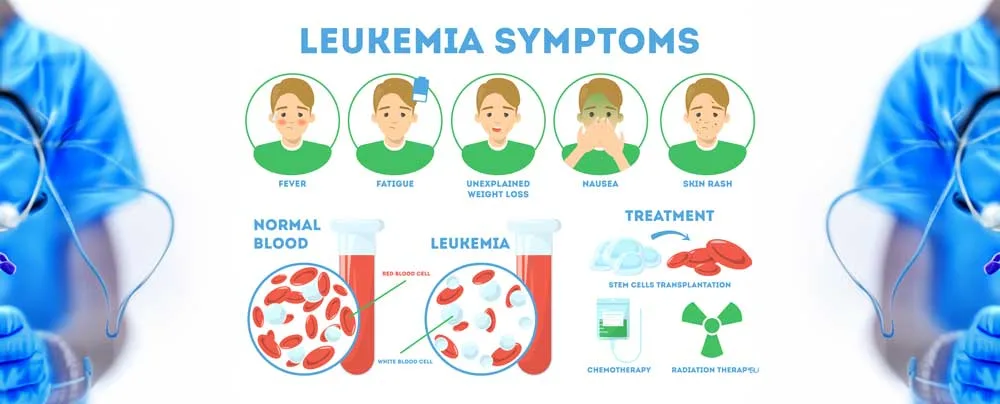
In the realm of healthcare, knowledge is power. The ability to recognize the silent signs of leukemia empowers individuals to take charge of their health and make informed choices. A complex group of blood cancers can be daunting, but it is not invincible. Through early detection, prevention, and the support of a caring community, we can tackle this challenge head-on.
Understanding Leukemia
In all its forms, originates in the bone marrow, where blood cells are produced. This group of blood cancers can be broadly categorized into acute (rapidly progressing) and chronic (slowly progressing) types:
- Acute Lymphoblastic Leukemia (ALL)
- Acute Myeloid Leukemia (AML)
- Chronic Lymphocytic Leukemia (CLL)
- Chronic Myeloid Leukemia (CML)
Understanding the fundamentals of leukemia is the first step in unlocking its mysteries. Let’s embark on a journey that covers recognition, prevention, and empowerment in simple terms.
Cracking the Leukemia Code
Leukemia, in simple terms, is a type of blood cancer that starts in the bone marrow. The bone marrow is like the factory where blood cells are produced. It’s important to know that leukemia comes in two main types:
1. Acute Leukemia (The Fast-Mover): This type of leukemia progresses rapidly, like a sprinter on the track.
2. Chronic Leukemia (The Slow-Pacer): On the other hand, chronic leukemia takes its time, like a leisurely walk in the park.
To make things even clearer, these two main types are further divided into four categories, almost like different teams within the same sport:
First Team: Acute Lymphoblastic Leukemia (ALL)
Second Team: Acute Myeloid Leukemia (AML)
Third Team: Chronic Lymphocytic Leukemia (CLL)
Fourth Team: Chronic Myeloid Leukemia (CML)
Symptoms of Leukemia
It presents a wide range of symptoms, many of which can be subtle in the early stages. It’s essential to be well-informed about these symptoms:
- Fatigue: A persistent and overwhelming sense of exhaustion is a common sign. This fatigue results from leukemia’s impact on red blood cells and their ability to carry oxygen.
- Frequent Infections: Leukemia weakens the immune system, leading to an increased susceptibility to infections. Frequent colds and illnesses that don’t resolve as expected can be a red flag.
- Unintentional Weight Loss: Losing weight without trying is a significant symptom, often resulting from leukemia’s impact on the body’s metabolism.
- Easy Bruising and Bleeding: Unexplained and easy bruising, prolonged bleeding from minor cuts, nosebleeds, or gum bleeding may occur due to a decrease in platelets, essential for blood clotting.
- Joint and Bone Pain: Persistent pain in the joints and bones can often be attributed to leukemia cells infiltrating the bone marrow.
- Swollen Lymph Nodes: Enlarged lymph nodes, particularly in the neck, armpits, and groin, may be a sign of leukemia’s impact on the lymphatic system.
- Pale Skin: A noticeable paleness of the skin can result from anemia, a condition induced by leukemia that leads to a decrease in red blood cells.
- Night Sweats and Fever: Recurrent episodes of night sweats and unexplained fever should not be ignored.
- Abdominal Discomfort: Pain, discomfort, or a feeling of fullness in the abdominal area, often due to an enlarged spleen.
- Headaches and Vision Changes: Frequent headaches and changes in vision, such as blurriness, can be neurological symptoms of leukemia.
Early Detection: The Game-Changer
Imagine leukemia as a puzzle, with each symptom being a piece. Early detection is the act of putting this puzzle together. The sooner these signs are recognized, the faster the puzzle reveals itself, allowing healthcare professionals to create targeted treatment plans.
Early diagnosis is crucial for several reasons:
Tailored Treatment
Early diagnosis allows healthcare professionals to tailor treatment plans to the specific type of leukemia and its stage. Different subtypes may respond better to particular therapies, and early identification ensures that the most effective approach is taken.
Enhanced Treatment Efficacy
The earlier diagnosed, the less opportunity it has to spread and disrupt the body’s normal functions. This means that treatments are more likely to be effective and that remission is a more achievable goal.
Reduced Complications
It can lead to complications such as severe infections, anemia, and bleeding disorders. Early diagnosis and treatment can either prevent these complications from occurring or reduce their severity.
Improved Quality of Life
These treatments can be challenging, and they often come with side effects. However, when diagnosed early, the treatments can be less aggressive, resulting in fewer side effects and an improved overall quality of life during and after treatment.
Prolonged Survival
Early diagnosis significantly increases the chances of prolonged survival. For some types and stages of leukemia, the prognosis can be quite favorable when the disease is detected in its early stages.
Preventing Secondary Effects
Leukemia can have secondary effects on various parts of the body, including the central nervous system and major organs. Early diagnosis can prevent these secondary effects from causing further harm.
Seeking Medical Attention
If you or someone you know is experiencing any of these symptoms or if you suspect that, don’t hesitate to consult a healthcare professional. They have the expertise and tools to conduct thorough evaluations, including blood tests, imaging, and medical examinations, that can lead to a definitive diagnosis.
The journey to conquering begins with awareness, early detection, and timely treatment. By familiarizing yourself with the symptoms, you become a proactive advocate for your health and the health of your loved ones.
Prevention: A Proactive Approach
While early diagnosis is crucial, prevention is equally significant. While not all the cases are preventable, certain lifestyle choices and precautions can potentially reduce the risk:
Healthy Lifestyle
- Diet: A well-balanced diet rich in fruits, vegetables, and whole grains provides essential nutrients and antioxidants that support the immune system and overall health.
- Exercise: Regular physical activity helps maintain a healthy weight, which, in turn, reduces the risk of leukemia.
- Smoking Cessation: Smoking is linked to a higher risk of leukemia. Quitting smoking can significantly lower this risk.
Environmental Awareness
Environmental factors can play a role in leukemia risk. While you can’t control all environmental factors, you can take steps to minimize exposure to potential carcinogens:
- Chemical Exposure: Limit exposure to chemicals like benzene, which is known to increase leukemia risk. Follow safety guidelines in workplaces with potential chemical exposure.
- Radiation: Minimize exposure to ionizing radiation from sources like X-rays, and follow safety measures in radiology settings.
Regular Health Check-ups
As we mentioned earlier, regular health check-ups are vital for early leukemia detection. Annual physicals and blood tests can help identify potential issues early, enabling timely intervention.
Genetic Counseling
In some cases, Results from genetic mutations. If you have a family history of leukemia or other blood-related cancers, consider genetic counseling. This can help you understand your risk and take appropriate steps.
Awareness and Education
Being informed and spreading awareness is another form of prevention. Educate yourself and your community about leukemia and its risk factors. The more people know, the more likely they are to take preventive measures and seek early diagnosis when necessary.
Support Research
Supporting leukemia research indirectly contributes to prevention. By funding studies and clinical trials, you help advance our understanding of the disease and develop better prevention strategies.
Advocacy for Regular Health Check-ups
Prevention is always better than cure. Regular health check-ups are the first line of defense against diseases like leukemia. Routine blood tests, physical examinations, and open conversations with healthcare providers can catch subtle signs before they escalate. We advocate for a proactive approach to health, where individuals prioritize their well-being through regular medical consultations.
The Role of Support Systems
Facing a potential leukemia diagnosis can be overwhelming. Emotional support from family, friends, and even support groups can make a world of difference. Sharing knowledge about the silent signs of leukemia within your community can create a network of support, ensuring that no one faces this challenge alone.
Moving Forward with Hope
It may cast a shadow, but hope is a powerful antidote. Advances in medical research and treatment options continue to brighten the landscape of leukemia care. By staying informed, advocating for regular health check-ups, and supporting one another, we can face with resilience and determination.
Empowerment Through Knowledge
In the realm of healthcare, knowledge is power. Understanding the subtle signs of leukemia empowers you to take charge of your health or support others in their journey. It though daunting, is not invincible, especially when identified early. Through early detection, prevention, and the support of a caring community, we can tackle this challenge head-on.
Conclusion
Recognizing the symptoms and seeking medical advice promptly is the first step in the battle against this formidable disease. Early diagnosis saves lives, and through vigilance, we can change the course of leukemia and pave the way for healthier, more vibrant futures.
In the fight against leukemia, the collective impact of early detection, prevention, and empowerment is immeasurable. By sharing knowledge, fostering a community of empowered individuals, and supporting research, we can face with hope, resilience, and determination.
Tips
- Explore exercises: Incorporating regular exercise into your routine is vital for maintaining a lifetime of wellness. Engage in activities that suit your preferences and fitness level, such as cardiovascular workouts, strength training, or yoga.
- Harness the power of sleep meditation: Practice effective sleep meditation techniques to improve the quality of your sleep. Explore different mindfulness and relaxation exercises that can help calm your mind and promote restful sleep.
- Embrace morning meditation for beginners: Starting your day with a meditation practice can set a positive tone for the rest of the day. Begin with beginner-friendly morning meditation techniques to cultivate mindfulness, clarity, and a sense of calm.
By incorporating these tips into your lifestyle, you can unlock the secrets to a lifetime of wellness. Learn more at www.topblogtrends.com.
Frequently Asked Questions
What is leukemia, and how does it develop?
Leukemia is a type of blood cancer that starts in the bone marrow, where blood cells are produced. It develops when there is an overproduction of abnormal white blood cells, which crowd out healthy cells.
What are the different types of leukemia, and how are they categorized?
Leukemia is categorized into four main types: Acute Lymphoblastic Leukemia (ALL), Acute Myeloid Leukemia (AML), Chronic Lymphocytic Leukemia (CLL), and Chronic Myeloid Leukemia (CML).
What are the common symptoms of leukemia?
Common symptoms include fatigue, frequent infections, unexplained weight loss, easy bruising and bleeding, joint and bone pain, swollen lymph nodes, pale skin, night sweats, fever, abdominal discomfort, headaches, and vision changes.
How can I recognize the silent signs of leukemia?
The silent signs of leukemia can be subtle but include unusual fatigue, frequent infections, unexplained weight loss, and easy bruising. Recognizing these signs early is crucial.
Can leukemia be prevented, and what lifestyle choices can help reduce the risk?
While not all leukemia cases are preventable, a healthy lifestyle, including a balanced diet, regular exercise, and smoking cessation, can reduce the risk. Minimizing exposure to chemicals and radiation also plays a role.
What is the importance of early detection in leukemia?
Early detection is crucial for tailoring treatment, enhancing treatment efficacy, reducing complications, improving the quality of life during and after treatment, prolonging survival, and preventing secondary effects.
How can I support leukemia research and advocacy efforts?
You can support research by participating in clinical trials, funding studies, and spreading awareness. Advocacy can involve hosting awareness events, seminars, and supporting organizations dedicated to leukemia.
What role do support systems play in leukemia management?
Emotional support from family, friends, and support groups is vital for those dealing with leukemia. Sharing knowledge about the disease within the community creates a network of support.
What is the outlook for leukemia patients in terms of treatment and advancements in care?
The outlook for leukemia patients is improving due to advances in medical research and treatment options. Early detection and tailored therapies are increasing the chances of remission and longer, healthier lives.
How can I empower myself and others to face leukemia with hope and determination?
Empowerment comes through knowledge and a positive outlook. Being informed, advocating for regular health check-ups, supporting one another, and spreading awareness contribute to a future where leukemia is faced with resilience and hope.






